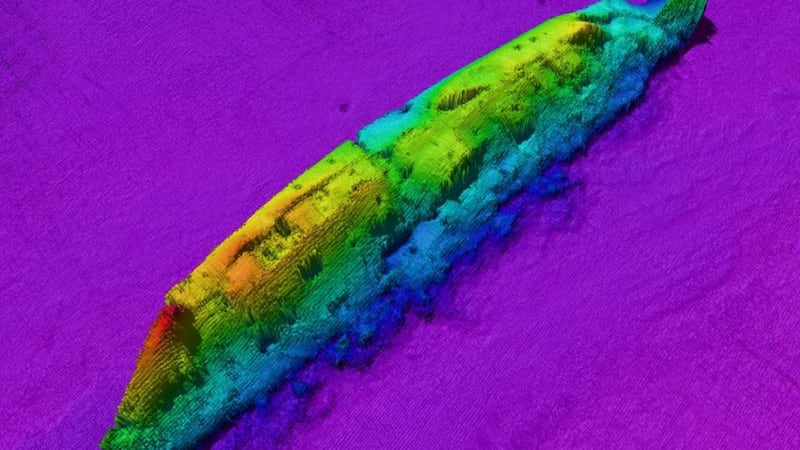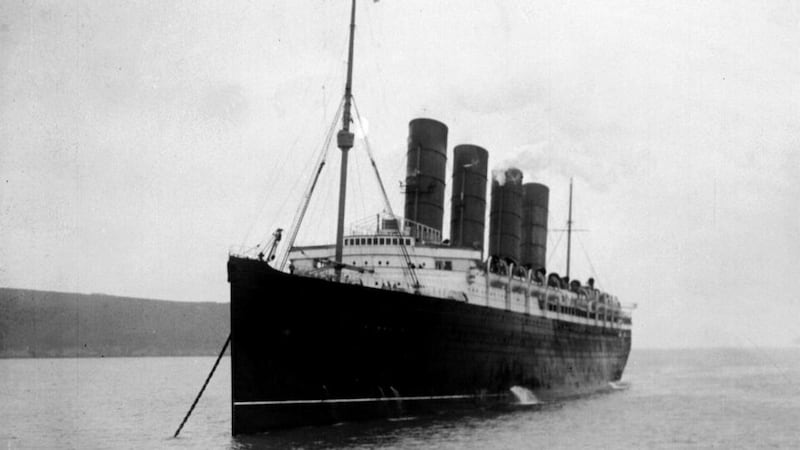New seabed imaging of the RMS Lusitania has been released ahead of the centenary of its sinking by torpedo on May 7th, 1915.
The sonar images have been produced by members of the Infomar (Integrated Mapping For the Sustainable Development of Ireland's Marine Resource) team at the Geological Survey of Ireland and the National Monuments Service of the Department of Arts, Heritage and the Gaeltacht.
The Cunard vessel was torpedoed by a German U-boat en route from New York to Liverpool and sank with the loss of 1,201 lives, including three unidentified stowaways.


President Michael D Higgins will be in Cobh in Co Cork on Thursday to mark the anniversary and Minister for Defence Simon Coveney will attend events at the Old Head Cork.
President Higgins will be welcomed at the Official Commemoration Ceremony by a full naval service guard of honour and the Band 1 Southern Brigade at 1.30pm.
He will be joined by British ambassador Dominick Chilcott, American ambassador Kevin O’Malley, Germany’s ambassador Matthias Hopfner, chairman of Carnival UK, David Dingle, and Port of Cork chairman John Mullins.
The ceremony will include a minute silence, blessings and hymns, and a wreath laying ceremony by President Higgins and the British, German and US ambassadors at the Lusitania Monument in Cobh’s Town Square.
Ahead of the events, Minister of State with responsibility for Natural Resources Joe McHugh and Minister for Heritage Heather Humphreys welcomed the publication of the sonar imagery.
A statement from the Ministers said the condition of the Lusitania on the seafloor, 100 years after its sinking, is revealed in greater detail than before. “The 240m vessel is clearly defined, lying on its starboard side and standing over 14m above the seabed,” it said.
Mr McHugh said the new imagery “provides the most detailed information and overview of the wreck site compiled to date”, providing a solid framework upon which new research and analysis can be based.
Ms Humphreys added “The imagery will provide important information on how the shipwreck has changed over the last 100 years.”
Site protection
This data is important from a site protection point of view, she said, adding to knowledge and understanding of the wreck site.
The centenary of the sinking will be marked on the sunken vessel itself by a red rose, plaque and the names of the hundreds of souls who perished being placed onboard.
Gregg Bemis, the 87-year-old US entrepreneur who owns the liner 11 miles off the Cork coast, created his own tribute rather than attend official commemorations.
The mementos will be placed on the boat 300ft below the surface, off the Old Head of Kinsale, at 2.15pm on Thursday - the exact time the torpedo consigned the liner to its watery grave.
“It will be a permanent recognition of our feelings about the importance of the wreck — and to pay homage to the victims,” Mr Bemis said.
Diver Eoin McGarry, who has been on the wreck more than anyone, will descend to the frigid Atlantic seabed to leave the tribute.
“They say no flowers can be laid on a sailor’s grave but in this instance we are going to lay a flower on it,” he said.
Second explosion theories
The Lusitania sank 18 minutes after being struck - compared to two hours and 40 minutes for the Titanic - sparking theories over a second explosion caused by a secret cargo of high explosives destined for the British war effort.
The plaque, flower and list of names will rest near the ship’s bridge between two bollards.
There is also a theory that the captain ordered full steam ahead after the torpedo hit near the ship’s bow forcing water into the vessel at a dramatic rate.
Also for the centenary, a minute’s silence will be held at a special service at Old Head overlooking the wreck site, while a plaque will also be unveiled and wreaths laid at the memorial.
The restored signal tower at the spot will also be officially opened.
Mr Bemis said he recognised the importance of the official anniversary engagements but said he planned the personal tribute as he relates more to the shipwreck.
Last year he sought permission from the Government to recover the double-faced bridge telegraph, visible on the wreck and potentially recording the last instruction from Capt William Thomas Turner to the engine room after the torpedo strike.
But he has been dispute with officials over onerous conditions imposed on a licence for anyone to legally dive on the wreck.
“To my mind there’s been a huge cover-up of the actual cause of the fast sinking. I think that’s abysmal,” Mr Bemis said.
Mr Bemis has spent decades trying to confirm a theory that the 18-minute sinking was hastened by a second explosion caused by a secret cache of munitions destined for Britain’s war effort.
Mr Bemis said: “If there’s one thing I can do while I’m still here on Earth I’d like to clarify that, by getting the honesty and integrity of what happened out in the open, how it happened, why it happened.”
Diving restrictions
He has held meetings in the last week with lawyers as they assess options for a lawsuit against the State over diving restrictions.
The businessman from New Mexico invested in the wreck for salvage in the 1960s and now claims diving on it could leave him open to claims from descendants of the dead for the desecration of graves.
Of 18,000 wrecks lying in seas around Ireland, the Lusitania is the only one with a ministerial order declaring it of cultural and historical significance.
It was placed amid claims that art collector Sir Hugh Lane brought valuable paintings on board including works by Rubens.
Built in the Clyde shipyards, RMS Lusitania was the jewel in the Cunard crown and the fastest ship on the Atlantic, having taken the Blue Riband in 1907.
Most of the dead were British, although 114 Americans were also killed, and the sinking was one of a series of events which prompted the US to join the fight against Germany in the First World War in 1917.
Additional reporting: Press Association













